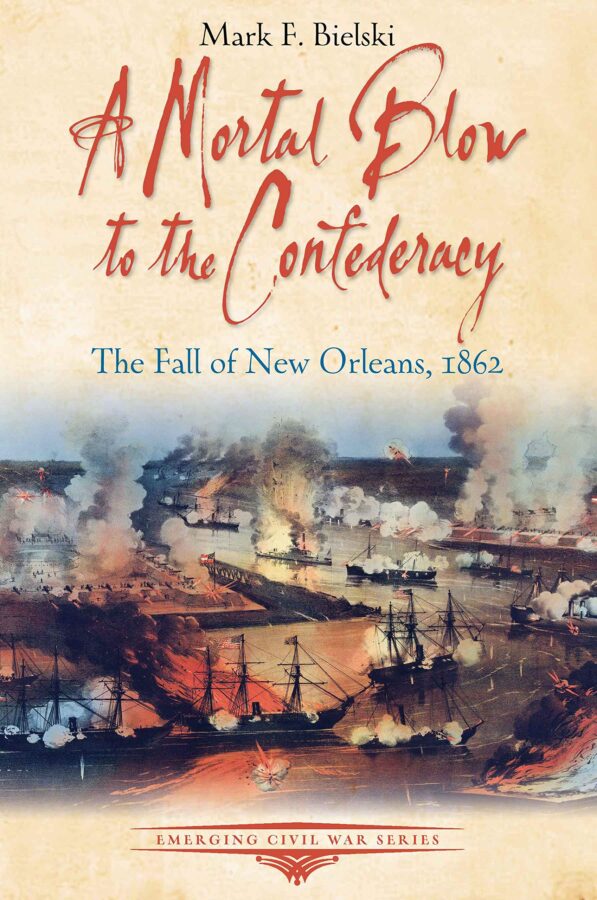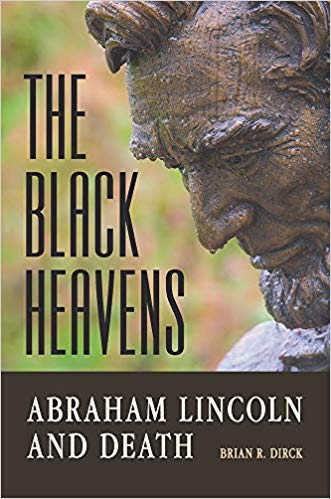A Mortal Blow to the Confederacy: The Fall of New Orleans, 1862 by Mark F. Bielksi. Savas Beatie, 2021. Paper, ISBN: 978-1611214895. $14.95.
 When one thinks of the Civil War, they often think of the blood-soaked battlefields between Washington, D.C., and Richmond. This “Virginia-centric” mindset has dominated the historiographical landscape for much of Civil War history. More recent scholars have taken an interest in the events of the western and trans-Mississippi theaters. While many historians have agreed with Abraham Lincoln that the “key” to Union victory was the capture of Vicksburg, historian Mark F. Bielski, in the most recent addition to the Emerging Civil War series from Savas-Beatie, argues that the fall of New Orleans dealt a “mortal blow” to the Confederacy.
When one thinks of the Civil War, they often think of the blood-soaked battlefields between Washington, D.C., and Richmond. This “Virginia-centric” mindset has dominated the historiographical landscape for much of Civil War history. More recent scholars have taken an interest in the events of the western and trans-Mississippi theaters. While many historians have agreed with Abraham Lincoln that the “key” to Union victory was the capture of Vicksburg, historian Mark F. Bielski, in the most recent addition to the Emerging Civil War series from Savas-Beatie, argues that the fall of New Orleans dealt a “mortal blow” to the Confederacy.
With a population exceeding 170,000 at the start of the Civil War, New Orleans was one of the largest port cities in the world—and the largest in the Confederate South. Despite the economic importance of the city, it perplexed author Bielski, the director of Stephen Ambrose Historical Tours, why the Confederacy did not defend the city with more vigor (xvii). To his amazement, Civil War literature was relatively silent on the sequence of events that led to the capture of the Crescent City. By recounting the events that led to fall of New Orleans, Bielski argues that the Confederate government mismanaged operations in the western theater.
Beginning with antebellum New Orleans, Bielski describes the importance of the city and its economic power. Chief amongst its exports was cotton. Supplying much of Europe and New England with the cash crop, “King Cotton” proved an invaluable source of southern economic strength. Recognizing this, Union officials believed that if they could take New Orleans, they would deal the rebellion a mortal blow.
Realizing that federal forces could attempt to take the city, individuals such as P.G.T Beauregard, Thomas Overton Moore, and David E. Twiggs advocated augmenting the coastal defenses surrounding New Orleans. However, their calls went unheeded as President Jefferson Davis and other high-ranking rebel authorities did not feel as anxious about the situation in New Orleans (9). They believed that the real threat to the city came from upriver, and that only a lengthy and costly campaign would deliver Union forces to the city. By subscribing to this belief, Confederate authorities in Richmond gutted the city of much of its troops, redirecting those men to assist with operations in Virginia and the upper Mississippi River valley.
By the end of 1861, New Orleans had a new commander in Mansfield Lovell, as General Twiggs proved too old and too incompetent. Inheriting a disastrous situation, Lovell “had to make the best efforts with the available munitions and material” to defend the city (33). In this, he did his best, approaching his task with vigor and zeal. Ultimately, however, his efforts were in vain; the Union forces captured New Orleans in April 1862 (145-47). While many ex-Confederates and historians have heaped blame on Mansfield Lovell, Bielski presses home that events were beyond Lovell’s control. The “Confederate government,” the author concludes, “greatly mismanaged the war in the Western and Trans-Mississippi theaters” (148).
As the title suggests, A Mortal Blow to the Confederacy engages debates about where the Civil War was won and lost. Unlike previous works, Bielski suggests that the mortal blow to the Confederate states did not come at Vicksburg, but rather with the loss of its greatest city. Supporting his arguments with relevant archival work, maps, and a keen understanding of the New Orleans coastal region, Bielski’s account is highly recommended.
Riley Sullivan is an independent historian based in San Antonio.

